- Home
- Landscape Ideas
- Palm Surroundings
Landscaping Around a Palm Tree:
Design That Delivers the Wow!
Landscaping around a palm tree can enhance your featured palm.
But where do you start? Want to make your palm tree pop?
Whether you’re working with a stately Queen Palm or a cluster of Pygmy Date Palms, creating coordinated landscaping for your palm will turn heads!
Create a lush, tropical focal point to elevate your yard.
Feeling overwhelmed by so many palm trees?
You're not alone. We Understand your headaches! At Mission: Palm Trees you'll find clear answers to questions & Step-By-Step Guidance, from real people. With solutions to help. No puzzling shoptalk. No tiring research. So it's easy & fun for you.
Design Your Palm Tree Landscape With Purpose
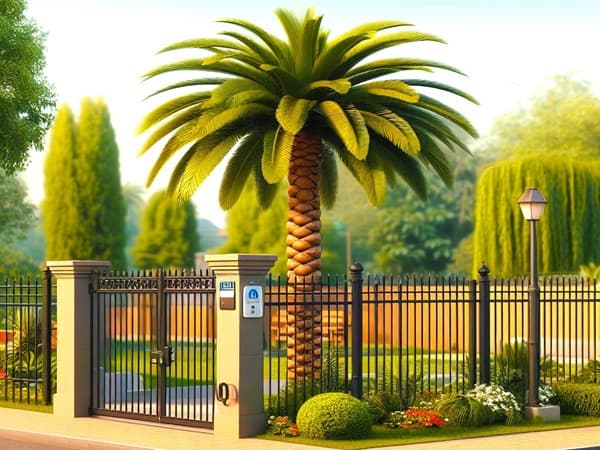
Palm trees naturally draw the eye upward. But what about below?
Done right, landscaping at the base of a palm creates a visual anchor. It sets the mood: exotic, elegant, or even inspirational.
Which tropical plants would you prefer? Or even tropical-looking plants?
Choose a style, then build from the ground up.
- Capitalize on using other palm species. For instance, Foxtail Palms as adjacent landscaping.
- Call upon stunning flowering tropical plants.
- Is there space for a rock garden, bench or pavers?
Match the Mood to the Climate
Think of your Initial Planning. What's the best way to be ready?
By placing the right plant in the right place!
- What is your climate? Know Your Planting Zone when choosing companion plants.
- How much sun shines around your palm tree? Direct sunlight or some daily shade?
Dry climate? Use rock mulch, succulents, and drought-tolerant blooms.
Humid climate? Go lavish with leafy greens, rich colors, and layered opulence.
Creative Palm Tree Landscaping Ideas:
Think Beyond the Basics
Don’t just throw in plants. Use contrast and parallells:
- When planting, consider the natural flow of rain water. And be sure your soil type has good drainage.
- Cash in on contrasting colors to brighten up your landscaping around the the palm you're enhancing.
- Turn to varied trunk patterns & textures, plus Palm Fruit colors for distinction.
- In cool climates, plan for species that can tolerate and Survive Cold Temperatures. Like Sago Palms (a cycad) or Windmill Palms.
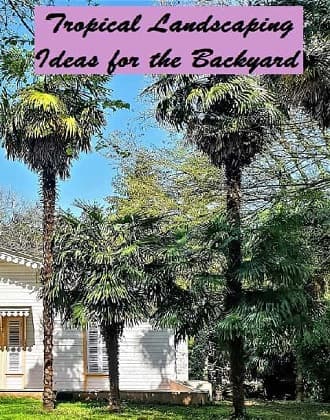
- Choose colors that pop against the trunk’s bark.
- Mix smooth-leaf plants with textured fronds.
- Use curved borders or stone edging for polish.
Here's a tip!
Choose a secondary feature plant (like elephant ears or bromeliads) and design around that, too. This keeps the area intentionally lush.
Your Palm Design Ideas - DIY or Hire It Out?
Make it more fun, with advantageous budgeting.
Do much of the design & garden work yourself. We do that (including helpful grandsons). Rather than hiring garden designers or landscapers when not essential.
Many tropical designs are totally DIY-able.
But bigger projects, especially those involving stone, lighting, or irrigation, may need expert hands.

Layered Beauty With The Tropical Trio
A key plant designing tip is to go with odd numbers of the same species.
Each layer plays a role. Together, they create an electrifying, textured effect that screams “resort-style living.”
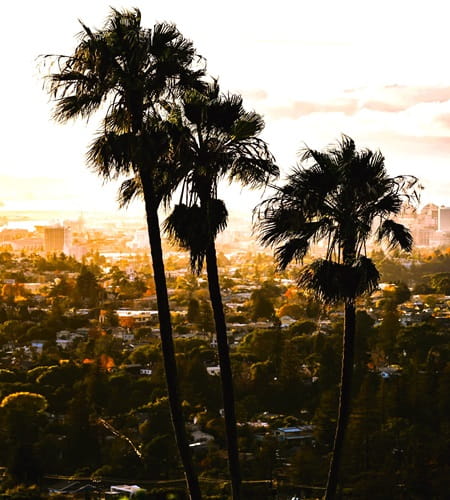 City Landscape With the Best Practice
City Landscape With the Best PracticeOdd Number of Palms
The Three Tiered Technique Around a Palm
Here's a stunning way to bring focus to your tropical garden design.
Use the 3-tier landscaping approach around your focus palm:
- Tall Accents – Think tropical grasses, small palms, red ti plants, or upright ferns.
- Mid-Level Interest – Shrubs like Crotons or low-growing Hibiscus.
- Ground Cover – Lush green moss, colorful pebbles, short grasses, or mulch.
This plant layering technique makes a delightful effect. It draws the eye upward, adding depth to your landscape.
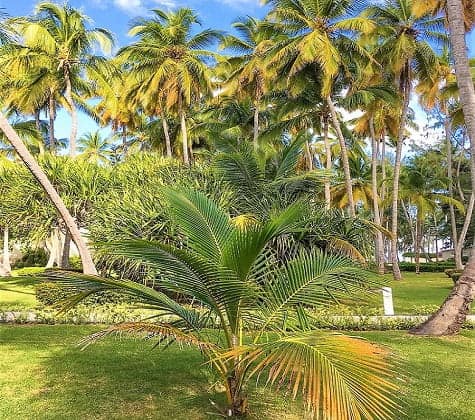 An Example of the Eye Being Drawn Upward
An Example of the Eye Being Drawn UpwardFrom the Smaller Palm in Front to Those Large Palms
Tons of Possibilities for that Mid-Level Row
Imagine these potentials:
Plant a bed of short tropical flowering plants. For a pop of color amidst all the green.
- Perhaps Tropical Hibiscus for Zones 9-11 (Hibiscus rosa-sinensis)
- Or the Falling Star (Crocosmia aurea) even works for Zone-6.
Intermix tropical greens like Taro (Colocasia esculenta) with flowering plants. Or plant the greens together, with low flower beds in front of them.
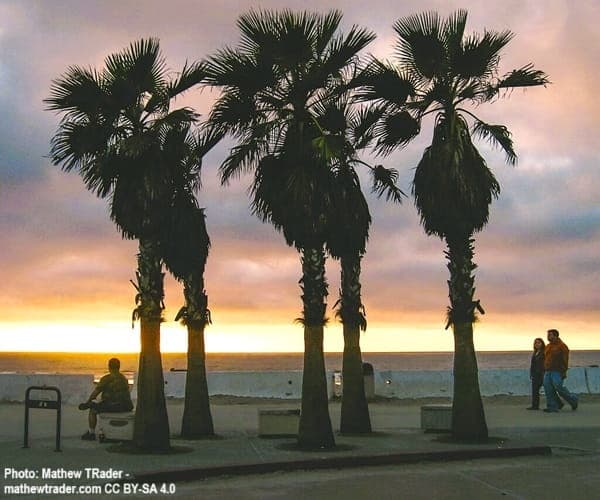 Five palms during a Pacific sunset.
Five palms during a Pacific sunset.Why not have a tropical flower garden surrounding the palms?
Top Ideas Using Palms for Landscaping
Around A Palm Tree
Double row palm landscaping works well for expansive yards. But with creativity and attention to palms' total growth, it can work on smaller properties, too.
Fit in a double row of palms with with your already growing standalone palm tree landscaping. Here are suggestions, whether your current focus palm is large or small:
- Plant two more of the same species of palm trees as the one you already have. You'll have palm triple-row landscape at varying heights.
- Then add a second row of smaller palms in front. Plant two more, for a total of five, staying with the odd-number principle.
 A Property With Three Coconut Palms Near Each Other
A Property With Three Coconut Palms Near Each OtherThen Two Smaller Palms in Front.
What Could Be Done Better?
Plant four palms, two on each side of your featured palm.
- In front of them for the second row, plant the best ground cover for palm trees by adding palms that act as ground covers.
- Like Chamaedorea microspadix or Chamaedorea cataractarum.
Poolside Palms for Landscaping
You Have Poolside palms?
Pick low-maintenance, non-shedding plants that love water and resist splash zones.
Is your current palm tree near your pool, as a standalone? Is that palm among one of those Tall Palm Trees, as your poolside focal point? But now it looks lonely! 🫤
Place three smaller palms around your featured palm area.
- Prepare a Mediterranean Fan Palm landscape plan.
- Or try landscaping with Pygmy Date Palms.
For places with arid climates, the Tree Morning Glory may be an alternate to the three palm trees.
Scatter tropically styled flowers suitable for your climate in between.
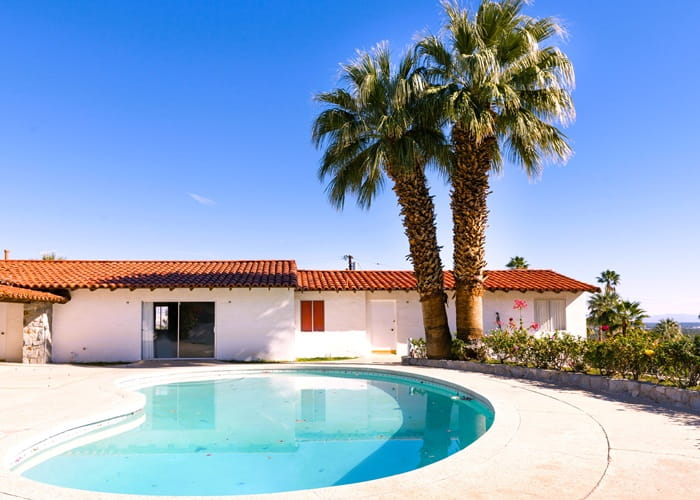 Line of Plants Adjacent to the Poolside Palms
Line of Plants Adjacent to the Poolside PalmsWhat Else Can Be Done? How About Placing Three Potted Palms?
Palm Tree Landscaping Ideas for Smaller Poolside Palms
You won't want to overwhelm smaller palms already at your poolside. Here are several things you could do:
- Surround it with three types of ornamental grasses, specific to your climate.
- Thinly plant one type of ornamental grass. Intermix these with three different species of flowering tropical plants that grow higher than your chosen grasses.
- Or just use tropical plants, like flowers. Three different colors would be stunning.
Adjacent to a Huge Palm & a Neighbor's Humungous Palm is Kind-of Overwhelmed!
Backyard Landscaping With Palms
Want to place landscaping around your backyard palm?
Think of the current placement & size of your palm.
- Is your palm close to any buildings? Like your own home.
- You won't want to obstruct window views with new plantings. Choose additions to coordinate with expectations.
 Front Windows Have Wonderful Viewpoints. How About Out the Home's Side Windows?
Front Windows Have Wonderful Viewpoints. How About Out the Home's Side Windows?- Do you have children who use backyard play areas? Avoid palms well-armed with spines.
- Are you looking for privacy landscaping with palms?
Here's an idea:
Front Yard Landscaping Ideas With Palm Trees
Front yards are neighborhood displays.
Plan carefully without overwhelming a hospitable entrance. Think of your current palm's placement. Two smaller palms nearby may be suitable. Surrounding the three with some flower beds.
Here's a jungly front yard landscaping idea.
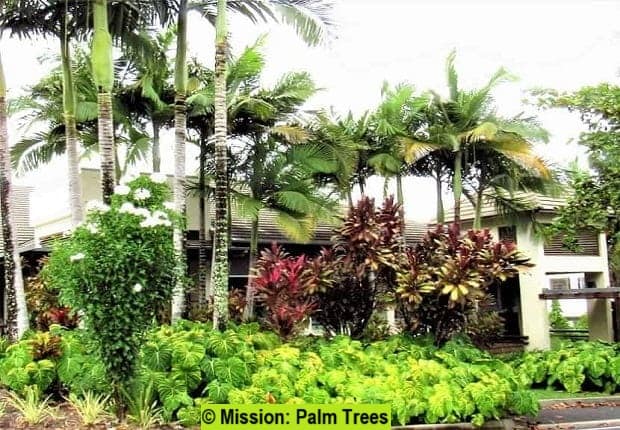 Nicely Layered Plants of the Tropics
Nicely Layered Plants of the TropicsPindo Palm Trees for Your Front Yard Design
Butia capitata is also called Jelly Palm. A hardy flexible palm, for zones 8-11. Adaptable to arid type areas, or those with more rainfall. And full sun or part shade.
- Producing edible fruit, invite neighbors to sample them. Or gather them for recipes. Otherwise cut down its yellow-flowering stalks after fading, to avoid fruiting.
- Solitary trunk to 35ft/10m tall. Nice size to accompany your tall front yard palm.
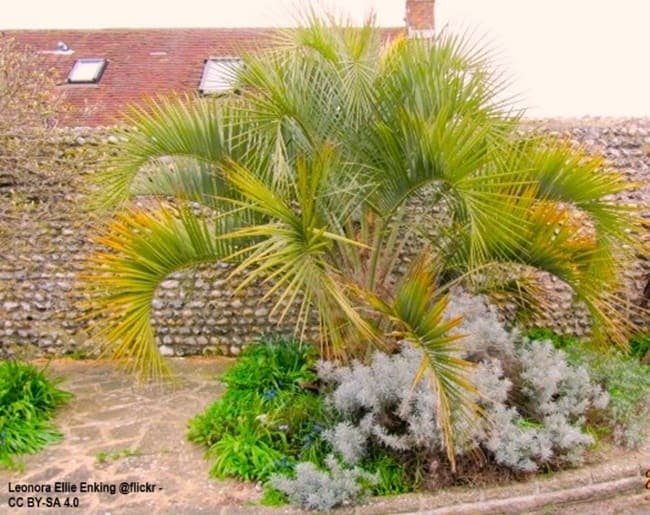 Surrounding the Palm With Compatible Tropicals in a Tight Space
Surrounding the Palm With Compatible Tropicals in a Tight SpaceLandscaping Design With Desert Palm Trees
Do you live in an arid climate?
Do you have a Mexican Fan Palm or Canary Island Date Palm?
These drought-tolerant palms are great amidst your cacti.
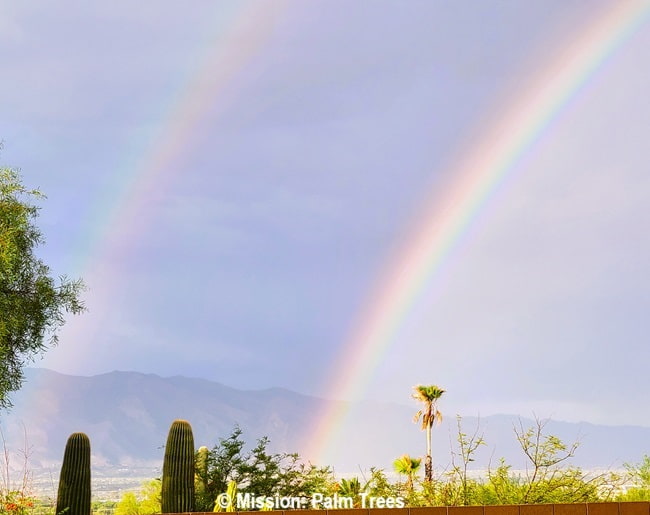 Cacti to the Left, Palms to the Right - Rainbow Up Above!
Cacti to the Left, Palms to the Right - Rainbow Up Above!Maintain Palm Tree Health
Within Your Landscape Design
You want to keep your original palm tree species healthy.
Maintaining your focal feature with your surrounding landscaping. That palm has its own soil type conditions & especially the ideal fertilizer with Important Nutritional Needs.
- It won't match up with fertilizer for the lawn or native flower beds you'll plant.
- Solve it by ensuring there's empty soil space under the crown. Whether you mulch or not.
DON'T DO THIS
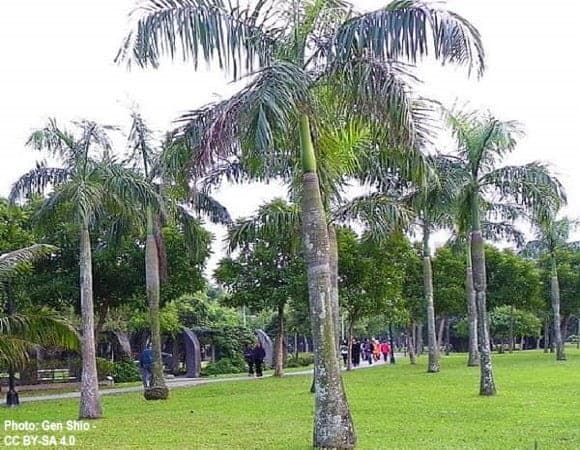 Not Ideal for Royal Palms in This Park. They Won't Do Best With Grass Fertilizer.
Not Ideal for Royal Palms in This Park. They Won't Do Best With Grass Fertilizer.INSTEAD, DO THIS
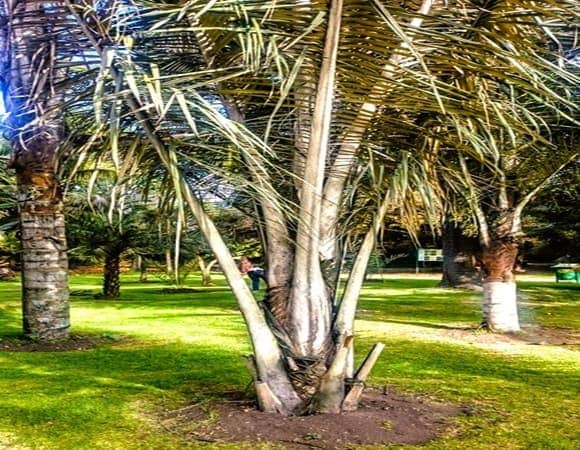 The Turf is Away From these Palms
The Turf is Away From these PalmsBest to Keep the Turf Away from the Trunk
Palm Trees for Landscaping
Tips for Landscaping With Pygmy Date Palms
Phoenix roebelenii is an ideal clustering (usually) triple-growth accompaniment. Excellent for planting for bringing the eye to your Tall Palm Tree.
- Likes dryer warmth, US Planting Zones 9-11; 8 may be fine. Known to tolerate momentary freezes.
- Slow growing to at least 6ft/2m tall.
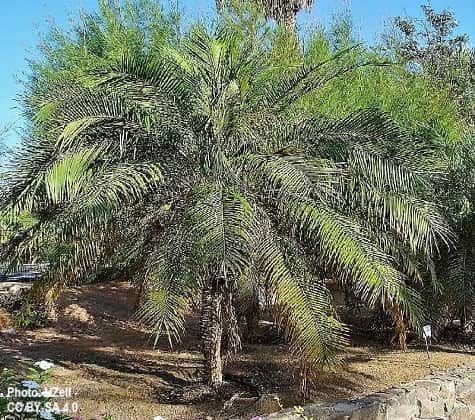 Pygmy Date Palms are pretty thirsty & want full sun.
Pygmy Date Palms are pretty thirsty & want full sun.Mediterranean Fan Palm Landscaping in Your Garden
Chamaerops humilis, aka European Fan Palm, Zones 8-11.
- Can spread out to 30ft/9m wide, making a good choice for a layering plan. Growing slowly, it may reach 20ft/6m tall.
- Watch out for frond petiole (stem) endings: nasty spines!
- When landscaping around a palm tree armed like this one, keep them away from walkways.
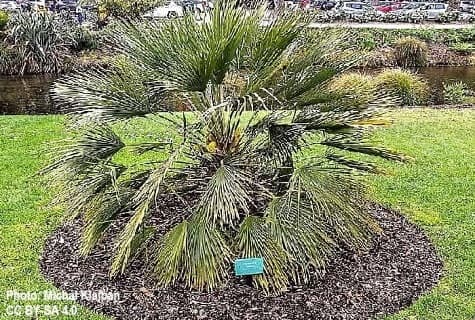 Begins With a Single Trunk
Begins With a Single Trunk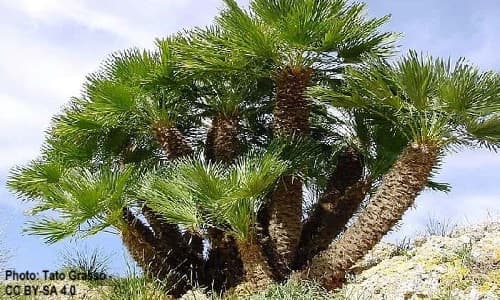 New Trunks Cluster Outward as It Grows
New Trunks Cluster Outward as It GrowsHardy Bamboo Palm for Your Landscape
Chamaedorea microspadix is very cold hardy. If Damaged by Extreme Cold, it can regenerate.
- Gets 12ft/4m tall, spreading 8ft/2.4m wide.
- Dark green stem has whitish rings, reminiscent of bamboo. Nice landscape feature.
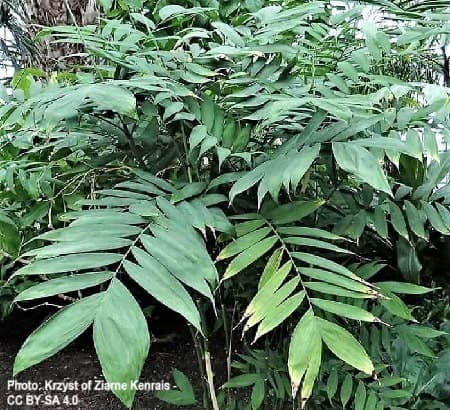 Hardy Bamboo Palm
Hardy Bamboo PalmIt Tolerates Some Cold Temperatures.
And Comes Back From the "Dead"
Cataract Palm Trees in Your Landscaping
Chamaedorea cataractarum is native to Mexican rain forests. Best in Zones 9b-11.
- Clustering palm gets about 6ft/2m tall, expanding to 8ft/2.4m feet wide.
- Loves water. Humidity with partial sun, too.
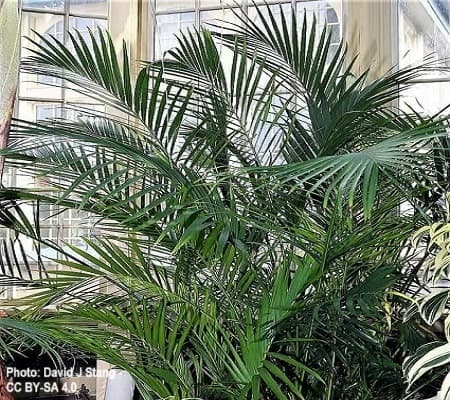 Often Called Cat Palm for Short. An Ideal Ground Cover.
Often Called Cat Palm for Short. An Ideal Ground Cover.Great choice to plant around a focus palm.
Dwarf Palmetto Palm Tree for Backyard Gardens
Sabal minor is the most northerly naturally growing U.S. palm. Flexible for temperate garden landscapes.
- Good for Zones 6-11. With caution try 5b.
- It likes water. Doesn't have to be in a swamp, but prefers moist soil. But tolerates drying out for a bit.
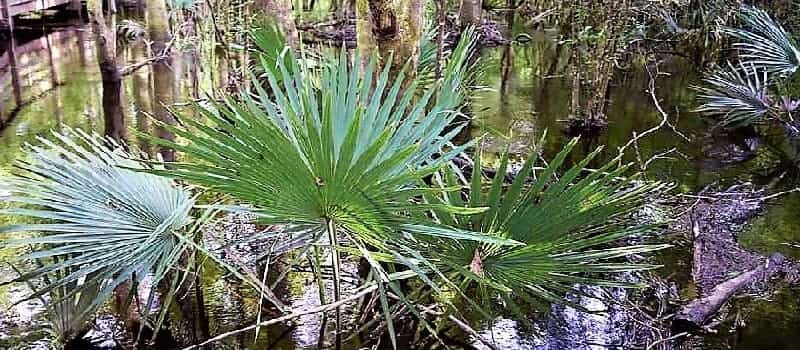 Dwarf Palmetto growing happily in a swampy preserve in a U.S. southern state.
Dwarf Palmetto growing happily in a swampy preserve in a U.S. southern state.Bismarck Palm Trees in For Drought Prone Gardens
Here's a drought-tolerant species of palm tree you could love! Bismarckia nobilis is medium sized (40ft/12m+) & is a stunner.
- Gorgeously silvery green palmate leaves give it a massive feel.
- Zones 9-11 can suit it fine. Water well until you have it established.
 Plant two, one on each side of your tall palm.
Plant two, one on each side of your tall palm.Mazari Palm Tree Landscaping for Best Ideas
Nannorrhops ritchiana is a full sun lover native to Middle Eastern desert hillsides. Why it's drought-hardy. Easy to Grow From Seed.
Good for Zones 8-11, and with watchfulness in 7. Quite low-temp tolerable in dry humidity areas.
- Slowly maxing to about 20ft/6m tall. Spreads to about 15ft/4.5m wide.
- Palmate fronds are wedge shaped or semicircular.
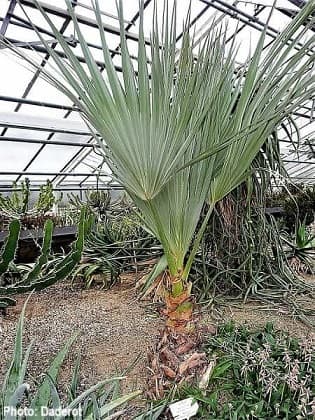 Triangular fronds could contrast well with round fronds of other fan palms.
Triangular fronds could contrast well with round fronds of other fan palms.Essential Safety Tips
For Palm Tree Landscaping Projects
Contact your local area's system for underground utility location. Essential when landscaping around a palm tree.
- You can google, as we've done: "find underground utilities in Tucson." Got the number for the free location service. Be aware some try to get you to hire them.
- Regulations may exist for distances to utility lines for plantings. You'd want to know that.
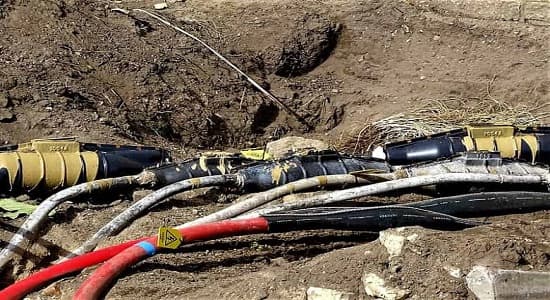 Don't Be Surprised by Hitting Into These! 😮
Don't Be Surprised by Hitting Into These! 😮More Precautions for Creating Your Tropical Landscapes
Are there prior homeowner underground sprinkler, electrical or drain installations? If you suspect that, dig slowly & carefully into your plant bed.
 Make Sure Your Tools Won't Be Shocking!
Make Sure Your Tools Won't Be Shocking!Wear eye protection when digging, raking, etc. Will you stir up dry soil, causing rising dust? Or using products with warning labels? Yuk! NO inhalation please...
- Inhaling that stuff can cause lung problems. If not immediately, it's possible further down the road. (Believe me, We Know!)
- A typical work N-95 mask is best.
 A Typical N-95 Mask Works Well
A Typical N-95 Mask Works WellFound in Hardware Stores
Avoid planting when you're too tired. Gardening while drinking alcohol or taking calming drugs can also be hazardous.
 Wanted to Do Landscaping - But Took a Nap Instead!
Wanted to Do Landscaping - But Took a Nap Instead!Landscaping Around a Palm Tree Takeaways
Landscaping around a palm tree isn’t just filler - it’s an opportunity to amplify tropical vibes.
There's a lot to think about for planning landscaping around a palm tree focal point. The key word is Planning! Along with imagination to visualize your end result.
Plant other palms? Plant palmy look-alikes? Plant small palms near the large one in a pleasing pattern or in rows. Plant other tropical plants?
Hope we gave you some helpful ideas to increase curb appeal and make your yard feel like paradise. Plan with purpose. Layer with style. And most of all… make it yours.




